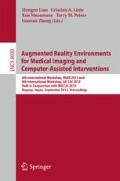Abstract
Accurate registration of diffusion tensor imaging (DTI) data of the brain among different subjects facilitates automatic normalization of structural and neural connectivity information and helps quantify white matter fiber tract differences between normal and disease. Traditional DTI registration methods use either tensor information or orientation invariant features extracted from the tensors. Because tensors need to be re-oriented after warping, fibers extracted from the deformed DTI often suffer from discontinuity, indicating lack of fiber information preservation after registration. To remedy this problem and to improve the accuracy of DTI registration, in this paper, we introduce a simultaneous tensor and fiber registration (STFR) algorithm by matching both tensor and fiber tracts at each voxel and considering re-orientation with deformation simultaneously. Because there are multiple fiber tracts passing through each voxel, which may have different orientations such as fiber crossing, incorporating fiber information can preserve fiber information better than only using the tensor information. Additionally, fiber tracts also reflect the spatial neighborhood of each voxel. After implementing STFR, we compared the registration performance with the current state-of-the art tensor-based registration algorithm (called DTITK) using both simulated images and real images. The results showed that the proposed STFR algorithm evidently outperforms DTITK in terms of registration accuracy. Finally, using statistical parametric mapping (SPM) package, we illustrate that after normalizing the fractional anisotropy (FA) maps of both traditional developing (TD) and Autism spectrum disorder (ASD) subjects to a randomly selected template space, regions with significantly different FA highlighted by STFR are with less noise or false positive regions as compared with DTITK. STFR methodology can also be extended to high-angular-resolution diffusion imaging and Q-ball vector analysis.
Access this chapter
Tax calculation will be finalised at checkout
Purchases are for personal use only
Preview
Unable to display preview. Download preview PDF.
References
Eluvathingal, T.J., Chugani, H.T., Behen, M.E., Juhasz, C., Muzik, O., Maqbool, M., Chugani, D.C., Makki, M.: Abnormal brain connectivity in children after early severe socioemotional deprivation: A DTI study. Pediatrics 117, 2093–2100 (2006)
Keller, T.A., Kana, R.K., Just, M.A.: A developmental study of the structural integrity of white matter in autism. Neuroreport 18, 23–27 (2007)
Yang, J., Shen, D., Davatzikos, C., Verma, R.: Diffusion tensor image registration using tensor geometry and orientation features. In: Metaxas, D., Axel, L., Fichtinger, G., Székely, G. (eds.) MICCAI 2008, Part II. LNCS, vol. 5242, pp. 905–913. Springer, Heidelberg (2008)
Wang, Y., Gupta, A., Liu, Z., Zhang, H., Escolar, M.L., Gilmore, J.H., Gouttard, S., Fillard, P., Maltbie, E., Gerig, G., Styner, M.: DTI registration in atlas based fiber analysis of infantile Krabbe disease. Neuroimage 55, 1577–1586 (2011)
Zhang, H., Avants, B.B., Yushkevich, P.A., Woo, J.H., Wang, S., McCluskey, L.F., Elman, L.B., Melhem, E.R., Gee, J.C.: High-dimensional spatial normalization of diffusion tensor images improves the detection of white matter differences: An example study using amyotrophic lateral sclerosis. IEEE Trans. Med. Imaging 26, 1585–1597 (2007)
Ziyan, U., Sabuncu, M.R., O’Donnell, L.J., Westin, C.-F.: Nonlinear registration of diffusion MR images based on fiber bundles. In: Ayache, N., Ourselin, S., Maeder, A. (eds.) MICCAI 2007, Part I. LNCS, vol. 4791, pp. 351–358. Springer, Heidelberg (2007)
Xue, Z., Li, H., Guo, L., Wong, S.T.: A local fast marching-based diffusion tensor image registration algorithm by simultaneously considering spatial deformation and tensor orientation. Neuroimage 52, 119–130 (2010)
Yeo, B.T., Vercauteren, T., Fillard, P., Peyrat, J.M., Pennec, X., Golland, P., Ayache, N., Clatz, O.: DT-REFinD: diffusion tensor registration with exact finite-strain differential. IEEE Trans. Med. Imaging 28, 1914–1928 (2009)
Wang, Q., Yap, P.-T., Wu, G., Shen, D.: Diffusion tensor image registration with combined tract and tensor features. In: Fichtinger, G., Martel, A., Peters, T. (eds.) MICCAI 2011, Part II. LNCS, vol. 6892, pp. 200–208. Springer, Heidelberg (2011)
Alexander, D.C., Gee, J.C., Bajcsy, R.: Similarity measures for matching diffusion tensor images. In: British Machine Vision Conference, pp. 93–102 (1999)
Karacali, B., Davatzikos, C.: Estimating topology preserving and smooth displacement fields. IEEE Trans. Med. Imaging 23, 868–880 (2004)
Alexander, D.C., Pierpaoli, C., Basser, P.J., Gee, J.C.: Spatial transformations of diffusion tensor magnetic resonance images. IEEE Trans. Med. Imaging 20, 1131–1139 (2001)
Xue, Z., Shen, D., Davatzikos, C.: Statistical representation of high-dimensional deformation fields with application to statistically constrained 3D warping. Med. Image Anal. 10, 740–751 (2006)
Author information
Authors and Affiliations
Editor information
Editors and Affiliations
Rights and permissions
Copyright information
© 2013 Springer-Verlag Berlin Heidelberg
About this paper
Cite this paper
Xue, Z., Wong, S.T.C. (2013). Simultaneous Tensor and Fiber Registration (STFR) for Diffusion Tensor Images of the Brain. In: Liao, H., Linte, C.A., Masamune, K., Peters, T.M., Zheng, G. (eds) Augmented Reality Environments for Medical Imaging and Computer-Assisted Interventions. MIAR AE-CAI 2013 2013. Lecture Notes in Computer Science, vol 8090. Springer, Berlin, Heidelberg. https://doi.org/10.1007/978-3-642-40843-4_1
Download citation
DOI: https://doi.org/10.1007/978-3-642-40843-4_1
Publisher Name: Springer, Berlin, Heidelberg
Print ISBN: 978-3-642-40842-7
Online ISBN: 978-3-642-40843-4
eBook Packages: Computer ScienceComputer Science (R0)

